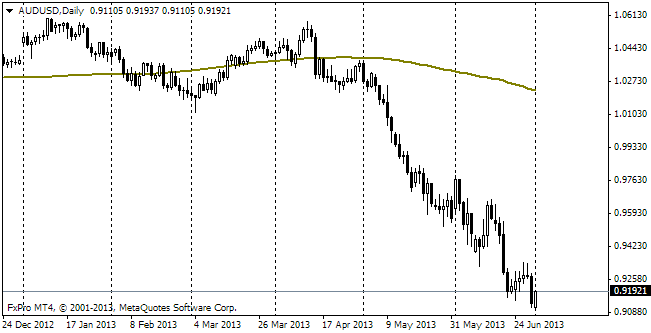EUR/usd
Just like on Thursday, Friday's trading got nowhere for EURUSD. The pair was drifting between 1.3250 and 1.3320. It happened since everybody already was in anticipation of the Fed's decision, which will be announced only this week, and since there was no important news, which could push the market beyond the traded levels. Such news came out a bit later, at the weekend. Lawrence Summers withdrew his name as a candidate for federal reserve chairman, which let the markets fly up at the weekly opening. The reason standing behind that is Summers' advocacy of the stimulus rollback in a much nearer future than Bernanke plans. This news spurred EURUSD at once to 1.3360 as compared to the weekly close of 1.3290. Such shifts are also observed in other exchanges, reacting to the fluctuations of the risk demand. S&P 500 futures grew by a percentage on the news and hit the historic high straight off. It's quite possible that the market participants will correct that growth on Monday, but the general mood is likely to remain positive. The thing is that despite the news about Summers market players have to consider worsening of the macroeconomic statistics from the USA. Friday's data on retail sales failed to surpass expectations and indicated sales growth in August at just 0.2% against the forecasted 0.5%. With car sales excluded, growth made 0.1%, which is also much worse than expected. A bit later Prelim UoM Consumer Sentiment was published. The indicator has been in the correction mode for two months already and has fallen to 76.8 in September in comparison with 85.1 in July. The preliminary inflation expectations have slightly increased, to 3.2%, but are still within the bounds of common fluctuations. Well, is the euro strong enough to continue growth against the dollar?

GBP/USD
The above-asked question can be paraphrased for the British currency as well. And here technical factors are coming into play as the pair is already approaching 1.60. The series of strong macroeconomic stats combined with the revision of the Fed's expectations let the pair climb to the levels which haven't been seen since January 2013. As you remember, in the first two months of 2013 the sterling sharply declined, depreciating by almost 10%. The current growth tide started off the yearly lows of 1.4812, which were hit in June. The cable, which is now trading at 1.5950, which is four figures off the yearly highs. These levels can be reached, but it will be hard without support of strong domestic statistics and clear weakness of the US currency.

USD/JPY
At the week's opening the pair was slipping to 98.44, but got support at the level of Friday's lows of the week before last and by now has recouped some of its losses, trading at 98.80. There is a suspicion that the Japanese investors may take advantage of the dollar's weakness for the further selling of the yen, which will again take the pair to 100.

AUD/USD
The aussie flew up to 0.9390 at the week's opening, but soon had to go on the defensive and retreat under the previous highs to 0.9330. To start growing the Aussie needs some reason, which cannot be found now. And weakness of the labour market will hardly make the RBA more courageous at the beginning of October, when the next rate decision takes place.
